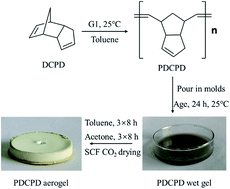Aerogels for the separation of asphalt-containing oil–water mixtures and the effect of asphalt stabilizer
Abstract
In order to separate the asphalt-containing oil–water mixture, an aerogel film was produced through supercritical drying of a polymer gel synthesized using the ring opening metathesis polymerization of dicyclopentadiene (DCPD). The polydicyclopentadiene (PDCPD)-based aerogels have a porous structure, super-lipophilicity and super-hydrophobicity which resulted in successful separation of the simple oil–water mixture, oil–water emulsion and asphalt-containing toluene–water mixture. However, the presence of asphalt decreases the separation efficiency by blocking the pores and acting as an emulsifier. An asphalt stabilizer was then employed to reduce the asphalt particle size and weaken the flow passage blockage, consequently improving the filtration speed and the asphalt content in the filtrate. The combination of PDCPD aerogel film with an asphalt stabilizer has great application prospects for separating asphalt-containing oil–water mixtures.



 Please wait while we load your content...
Please wait while we load your content...